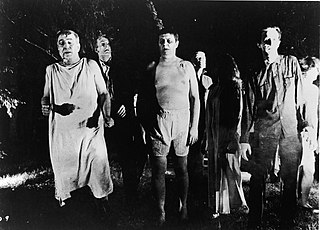Related Research Articles

Paramount Pictures Corporation is an American film and television production and distribution company and the main namesake division of Paramount Global. It is the fifth oldest film studio in the world, the second oldest film studio in the United States, and the sole member of the "Big Five" film studios located within the city limits of Los Angeles.

Metro-Goldwyn-Mayer Studios Inc. is an American media company, founded in 1924, that produces and distributes feature films and television programs. It is based in Beverly Hills, California.

A B movie or B film is a low-budget commercial motion picture. In its original usage, during the Golden Age of Hollywood, the term more precisely identified films intended for distribution as the less-publicized bottom half of a double feature. However, the U.S. production of films intended as second features largely ceased by the end of the 1950s. With the emergence of commercial television at that time, film studio B movie production departments changed into television film production divisions. They created much of the same type of content in low budget films and series. The term B movie continues to be used in its broader sense to this day. In its post-Golden Age usage, there is ambiguity on both sides of the definition: on the one hand, the primary interest of many inexpensive exploitation films is prurient; on the other, many B movies display a high degree of craft and aesthetic ingenuity.

United Artists Corporation (UA), currently doing business as United Artists Digital Studios, is an American digital production company. Founded in 1919 by D. W. Griffith, Charlie Chaplin, Mary Pickford, and Douglas Fairbanks, the studio was premised on allowing actors to control their own interests, rather than being dependent upon commercial studios. UA was repeatedly bought, sold, and restructured over the ensuing century. Metro-Goldwyn-Mayer acquired the studio in 1981 for a reported $350 million.
Major film studios are production and distribution companies that release a substantial number of films annually and consistently command a significant share of box office revenue in a given market. In the American and international markets, the major film studios, often known simply as the majors or the Big Five studios, are commonly regarded as the five diversified media conglomerates whose various film production and distribution subsidiaries collectively command approximately 80 to 85% of U.S. box office revenue. The term may also be applied more specifically to the primary motion picture business subsidiary of each respective conglomerate.

An independent film, independent movie, indie film, or indie movie is a feature film or short film that is produced outside the major film studio system, in addition to being produced and distributed by independent entertainment companies. Independent films are sometimes distinguishable by their content and style and the way in which the filmmakers' personal artistic vision is realized. Usually, but not always, independent films are made with considerably lower budgets than major studio films. In fact, it is not unusual for well-known actors who are cast in independent features to take substantial pay cuts if they truly believe in the message of the film, or if they are returning a favor to a filmmaker, or simply because they want to work with a particular director that they admire. There are many examples of the latter, such as John Travolta and Bruce Willis taking less pay to work with Quentin Tarantino on Pulp Fiction.
Walt Disney Studios Motion Pictures, formerly known as Buena Vista Pictures Distribution, Inc. until 2007, is an American film distribution studio within the Disney Media and Entertainment Distribution division of The Walt Disney Company. It handles theatrical and occasional digital distribution, marketing and promotion for films produced and released by the Walt Disney Studios, including Walt Disney Pictures, Walt Disney Animation Studios, Pixar, Marvel Studios, Lucasfilm, and 20th Century Studios; Disney's Searchlight Pictures label operates its own autonomous theatrical distribution and marketing unit.

William Wadsworth Hodkinson, known more commonly as W. W. Hodkinson, was born in Independence, Kansas. Known as The Man Who Invented Hollywood, he opened one of the first movie theaters in Ogden, Utah in 1907 and within just a few years changed the way movies were produced, distributed, and exhibited. He became a leading West Coast film distributor in the early days of motion pictures and in 1912 he co-founded and became president of the first nationwide film distributor, Paramount Pictures Corporation. Hodkinson was also responsible for doodling the mountain that became the Paramount logo in 1914. After being driven out of Paramount, he established his own independent distribution company, the W. W. Hodkinson Corporation, in 1917, before selling it off in 1924. He left the motion picture business in 1929 to form Hodkinson Aviation Corporation, and later formed the Central American Aviation Corporation and Companía Nacional de Aviación in Guatemala.

Cineplex Odeon Films was the film distribution unit of the Canadian cinema chain Cineplex Odeon Corporation. The company was originally named Pan-Canadian Film Distributors. In 1998, the company was sold off to Alliance Atlantis Communications, which eventually folded into Entertainment One.
A film distributor is responsible for the marketing of a film. The distribution company may be the same with, or different from, the production company. Distribution deals are an important part of financing a film.

Famous Players-Lasky Corporation was an American motion picture and distribution company formed on June 28, 1916 from the merger of Adolph Zukor's Famous Players Film Company—originally formed by Zukor as Famous Players in Famous Plays—and the Jesse L. Lasky Feature Play Company.

Beyond and Back is a 1978 documentary and "death-sploitation flick" released by Sunn Classic Pictures that deals with the subject of near death experiences.
Walter Reade was the name of a father and son who had an extensive career in the United States motion picture industry.

Film Booking Offices of America (FBO), also known as FBO Pictures Corporation, was an American film studio of the silent era, a producer and distributor of mostly low-budget films. It was founded in 1920 as Robertson–Cole (U.S.), the American division of a British import–export company formed by the English-born Harry F. Robertson. Robertson-Cole bought the Hallmark Exchanges from Frank G. Hall in 1920. Exhibitors-Mutual/Hallmark had distributed Robertson-Cole product, and acquiring the exchanges gave them the right to distribute their own films plus Hall's product, with the exception of Charlie Chaplin reissues which he had the rights to.

Cinema International Corporation (CIC) was a film distribution company started by Paramount Pictures and Universal Pictures in the early 1970s to distribute the two studios' films outside the United States – it even operated in Canada before it was considered part of the "domestic" market. During the 1970s, CIC was the "most important agent of overseas distribution" for American films. In 1981, CIC merged with United Artists' international units and became United International Pictures. The formation of CIC, and the profit-sharing arrangement that made it work, has been described as the product of "revolutionary thinking".

The Christian film industry is an aspect of Christian media for films containing a Christian-themed message or moral. They are often interdenominational films, but can also be films targeting a specific denomination of Christianity.
Sunn Classic Pictures, also known as Sunn International Pictures, Schick Sunn Classic Pictures, and Taft International Pictures was an independent U.S.-based film distributor, founded in 1971. The company was notable for family films and documentaries, and was purchased by Taft Broadcasting in 1980.

RKO Radio Pictures, Inc., commonly called RKO Pictures or simply RKO, was an American film production and distribution company that was one of the "Big Five" major film studios of Hollywood's Golden Age. The business was formed after the Keith-Albee-Orpheum (KAO) theater chain and Joseph P. Kennedy's Film Booking Offices of America (FBO) studio were brought together under the control of the Radio Corporation of America (RCA) in October 1928. RCA chief David Sarnoff engineered the merger to create a market for the company's sound-on-film technology, RCA Photophone. By the mid-1940s, the studio was under the control of investor Floyd Odlum.

Jensen Farley Pictures was an American independent film distribution company based in Utah that released several films between 1980 and 1983, founded by Raylan Jensen and Clair Farley, former heads of Sunn Classic Pictures. The company filed for Chapter 11 bankruptcy on December 30, 1983, and ceased distribution. The company's film library is presently owned by Paramount Global through Paramount Pictures.

Warner Bros. Pictures is an American film production and distribution company of the Warner Bros. Pictures Group division of Warner Bros.. The studio is the flagship producer of live-action feature films within the Warner Bros. Pictures Group unit, and is based at the Warner Bros. Studios complex in Burbank, California. Animated films produced the Warner Animation Group are also released under the studio banner.
References
- ↑ Austin, Bruce A. (1989). "The Film Industry and Audience Response". Immediate Seating: A Look at Movie Audiences. Wadsworth Publishing. pp. 12–13. ISBN 0-534-09366-3.
- 1 2 3 Wasser, Frederick (Winter 1995). "Four Walling Exhibition: Regional Resistance to the Hollywood Film Industry". Cinema Journal . University of Texas Press on behalf of the Society for Cinema & Media Studies. 34 (2): 51–65. doi:10.2307/1225836. ISSN 0009-7101. JSTOR 1225836.
- ↑ Goodell, Gregory (2003) [1982]. "The Distributors". Independent Feature Film Production: A Complete Guide from Concept Through Distribution. St. Martin's Griffin. p. 247. ISBN 0-312-30462-5 . Retrieved October 14, 2010.
- 1 2 Beck, Jerry (2005). "Journey Back to Oz". The Animated Movie Guide . Chicago Reader Press. p. 132. ISBN 1-55652-591-5.
- 1 2 Simens, Dov S.-S. (2003). "Do It Yourself". From Reel to Deal: Everything You Need to Create a Successful Independent Film. Warner Books. p. 384. ISBN 0-446-67462-1 . Retrieved October 14, 2010.
- ↑ McLeod, Michael (2009). "Show Time". Anatomy of a Beast: Obsession and Myth on the Trail of Bigfoot. University of California Press. p. 111. ISBN 978-0-520-25571-5 . Retrieved October 14, 2010.
- 1 2 "Management Team". Sunn Classic Pictures. Archived from the original on February 4, 2013. Retrieved October 14, 2010.
- ↑ "Film gives new twist to Lincoln assassination". The Day . New London, Connecticut. Associated Press (AP). May 23, 1977. p. 15. Retrieved October 14, 2010.
- ↑ "Will the Wall Survive Blasts? (New York Intelligencer)". New York . New York Media LLC. 7 (15): 66. April 15, 1974. Retrieved October 14, 2010.
- ↑ "Rolling Stones Excitement Captured in New Movie". Billboard . VNU/Nielsen Business Media. 86 (17): 17. April 27, 1974. Retrieved October 14, 2010.
- ↑ Jordan, Chris (2003). Movies and the Reagan Presidency: Success and Ethics . Westport, CT: Praeger Publishers. pp. 30. ISBN 0-275-97967-9.
- ↑ Holmlund, Chris; Wyatt, Justin, eds. (2005). "1970s distribution and marketing strategies". Contemporary American Independent Film: From the Margins to the Mainstream. Psychology Press. pp. 238–239. ISBN 0-415-25486-8 . Retrieved October 14, 2010.
- ↑ Gardner, Eriq (October 26, 2011). "How a Nasty Legal Fight Over 'Deep Throat,' 'Debbie Does Dallas' Was Settled". The Hollywood Reporter . Retrieved August 20, 2014.